If you’re planning on visiting the coast of British Columbia, you may be wondering what species of sharks pass through the coastal waters. While it’s not a reef-filled tropical haven, there are several temperate-cold water sharks that journey along this coastline and reside in the deeper regions offshore. In this guide, we’ll explore thirteen species of sharks found in British Columbia waters. Here’s a preview!

Continue reading to learn more!
The Ecosystem of British Columbia’s Coastline
Located on the westernmost side of Canada, British Columbia’s coast is bordered by the temperate waters of the North Pacific Ocean. The waters off British Columbia are packed with nutrients brought by cold water currents. This nutritious environment supports a complex, interdependent marine ecosystem from microbial zooplankton to a range of apex predators, including sharks. Sharks that live in the deep sea, open ocean, and shallow, near-shore environments can all be found near British Columbia’s coastline.
Additionally, beyond the coastal waters of British Columbia exists an intricate, unique ecosystem of seamounts. About 75% of Canada’s underwater mountains exist off British Columbia’s water. Many species of deep-water and open-ocean sharks benefit from these delicate mountainous ecosystems that are a hotbed for marine life.
13 Species of Sharks Found in British Columbia Waters
Below, we’ll discuss thirteen species of sharks found in British Columbia waters, some of which you can potentially spot from shore. The diversity of sharks in this region is high, with deep sea, open-ocean, and coastal species found in these waters.
While your interest in this guide may be driven more by fear of what sharks inhabit the waters you might swim in, it’s important to know that shark attacks in British Columbia are extremely rare. In 2022, there were 57 unprovoked shark bites on people worldwide. Of those encounters across the entire world, only five were fatal. In comparison, about 100 million sharks are killed by people each year. While some of this is from intentional fishing, this extremely high number also comes from bycatch and sharks dying tangled in fishing nets and debris that ends up in our oceans.
So, if you’re taking a trip to the coast of British Columbia, don’t fret too much if you take a dip in the water. You’re more likely to die by a TV set falling on your head than getting bit by a shark. On the flip side, if you’re excited about the possibility of seeing sharks while diving in this region, you might be in luck. 13 species of sharks are known to occur in these waters, and you might be lucky enough to spot one on an underwater adventure.
1. Salmon Shark (Lamna ditropis)
A species of mackerel shark found in the northern Pacific Ocean, the salmon shark (Lamna ditropis) can grow up to 10 feet long and weigh upwards of 1,000 pounds. off the shores of British Columbia, they feed on a variety of fish, marine birds, marine mammals, cephalopods, and of course, ocean-going salmon. This species inhabits both inshore and open-ocean waters. They can dive over 2,000 feet deep and have been seen feeding around the British Columbia seamounts. On average, male salmon sharks live about 27 years, and females tend to live about 20 years.
Sometimes, people mistake the salmon shark for a great white due to their similar appearance. This could especially be the case in mistaking an adult salmon shark for a juvenile or young adult great white. However, the real lookalike is the porbeagle shark which shares the Lamna genus with the salmon shark. In fact, before 1947, scientists had salmon sharks classified as the porbeagle (Lamna nasus). We now know that while these two sharks are related, the salmon shark is a separate Pacific Ocean species that does not share a range with the porbeagle inhabiting the Atlantic Ocean.
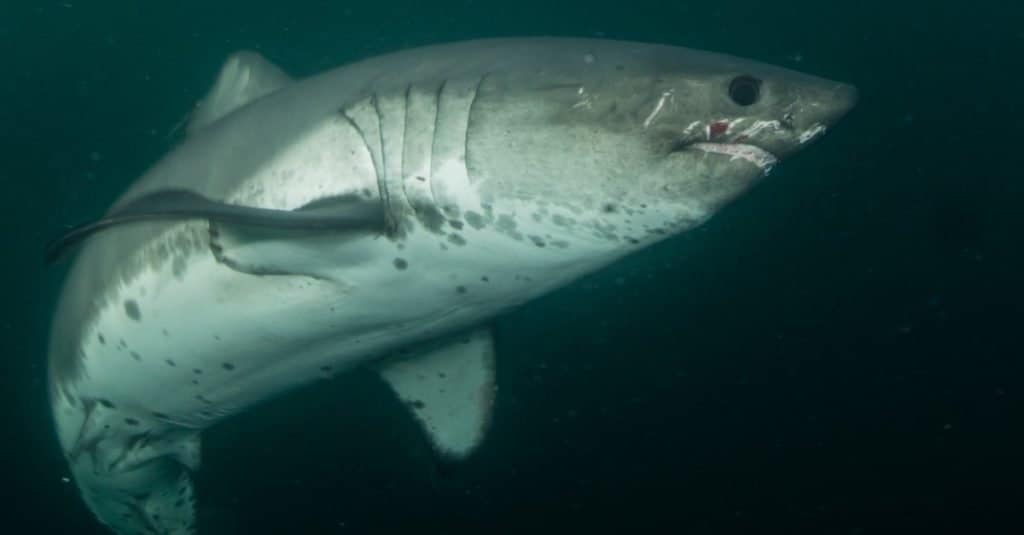
The salmon shark frequents the cool waters of the North Pacific and can reach up to 10 feet in length.
©Warren Metcalf/Shutterstock.com
2. Pacific Spiny Dogfish (Squalus suckleyi)
The spiny dogfish (Squalus acanthias) occupies an impressive range, able to live in open-ocean surface waters to depths of over 4,000 feet. This small shark grows only to about 3.5 feet, weights just 22 pounds, is streamlined, and features a grey-brown body and distinctly large eyes. This species of shark is quite long-lived, averaging a lifespan of 80 years.
Interestingly, the Pacific spiny dogfish bears a slightly venomous spine along the front of its two dorsal fins. This venom helps to protect against predators such as sixgill sharks and seals. This shark is most numerous near British Columbia during the spring and summer.
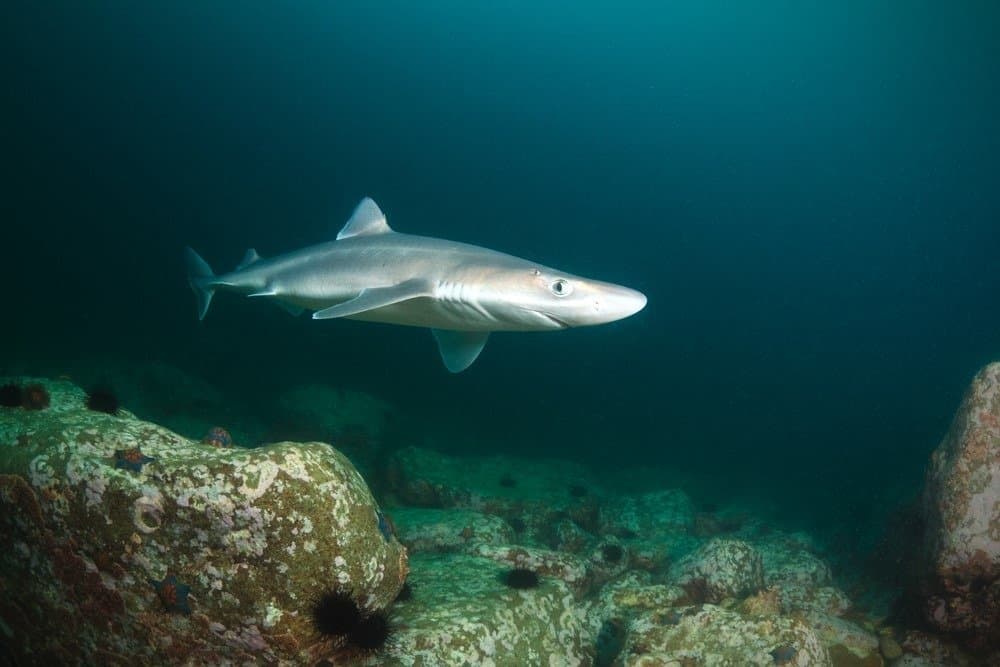
The Pacific spiny dogfish bears a slender, mildly venomous spine in front of each dorsal fin.
©Boris Pamikov/Shutterstock.com
3. Pacific Sleeper Shark (Somniosus pacificus)
The Pacific sleeper shark (Somniosus pacificus) is a delightfully strange-looking shark with an interesting routine. This wild-looking critter has a mottled, dark grey, cylindrical body and a rounded, short snout. The dorsal and pectoral fins are diminutive in size, giving this shark a torpedo-like appearance.
During the day, the Pacific sleeper shark tends to reside in extremely deep waters of over 6,000 feet. At night, they move up the water column and hunt a range of prey from giant Pacific octopus to salmon and harbor seals. This species of sleeper shark can reach up to 14 feet long and weigh almost 2,000 pounds. Experienced night divers swimming the open ocean off the coast of British Columbia might be lucky enough to see one of these elusive sharks. One of the most incredible facts about the sleeper shark is that scientists estimate this shark may live 250-300 years!
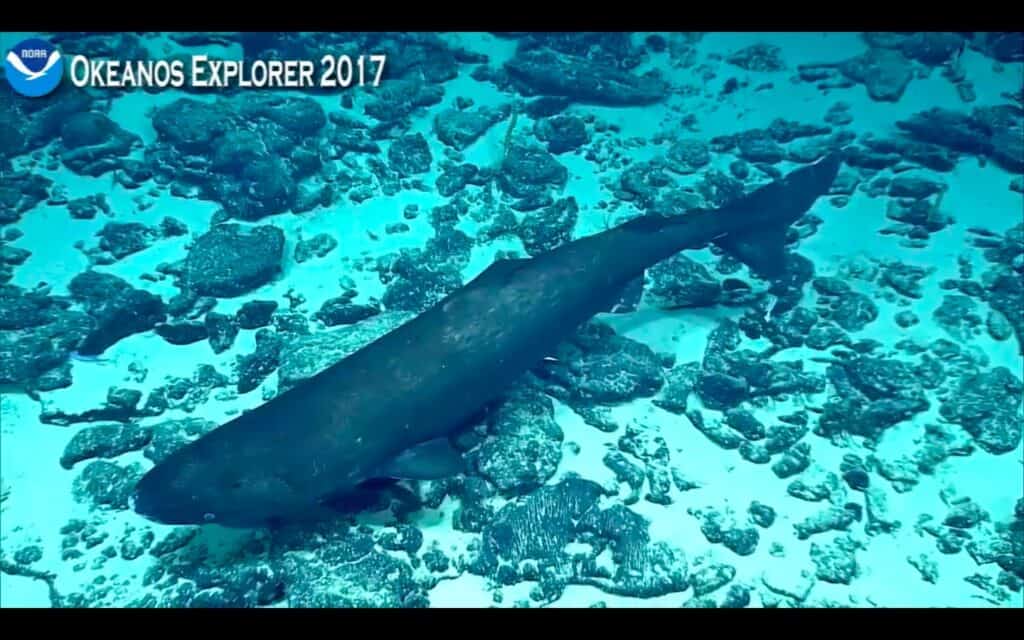
The Pacific sleeper shark is a nocturnal hunter, rising from the depths to hunt in shallow waters at night.
©Public Domain – License
4. Brown Catshark (Apristurus brunneus)
The brown catshark (Apristurus brunneus) grows to only about 2 feet long. These small sharks are primarily bottom dwellers of muddy or sandy regions down to about 3,000 feet. Off the shores of British Columbia, their diet consists largely of small crustaceans, krill, squid, and fish. Their body color is light to medium brown and their two small dorsal fins are equal in size.
Shark biologists believe the brown catshark may live as long as 80 years. They also are a slow-growing species, reaching reproductive maturity typically around 8-9 years old.
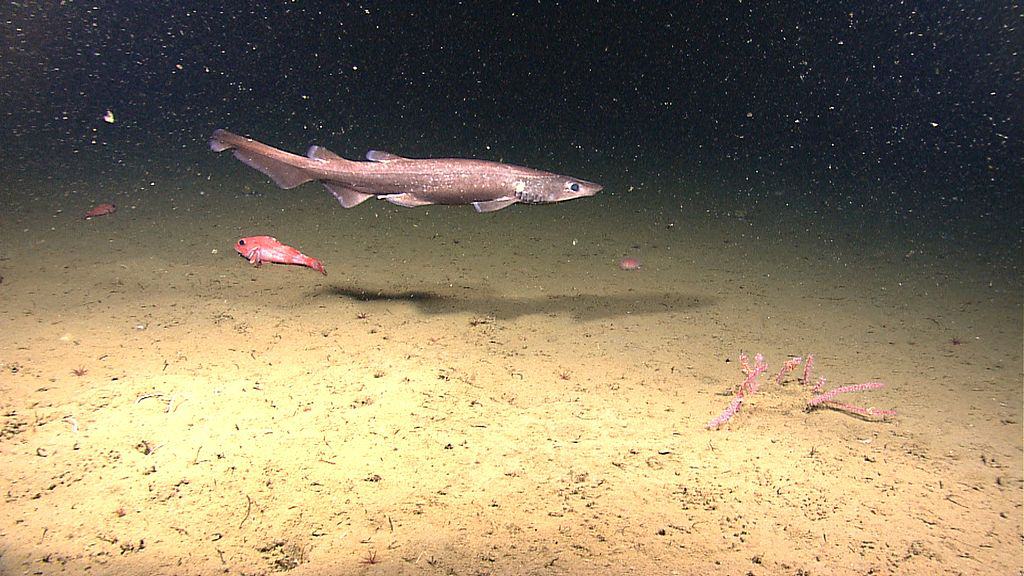
The brown catshark is a bottom-dweller that can be found along muddy and sandy seafloors down to about 3,000 feet.
© – License
5. Blue Shark (Prionace glauca)
The blue shark (Prionace glauca) is a wide-ranging shark occurring in the Atlantic, Pacific, and Indian Oceans in offshore and inshore waters. Off the coast of British Columbia, this species tends to live primarily among surface waters up to 300 feet deep. It features a notably indigo-blue upper body with bright blue sides and white coloring underneath.
This slender shark can reach up to 10 feet in length and hunts primarily squid, octopus, and open ocean fish such as herring, mackerel, tuna, and swordfish. Less often, blue sharks will hunt small seals. This slender, hydrodynamic shark can dive up to about 3,000 feet deep. This species of shark can live about 20 years, although their lifespan is cut dramatically in captivity.
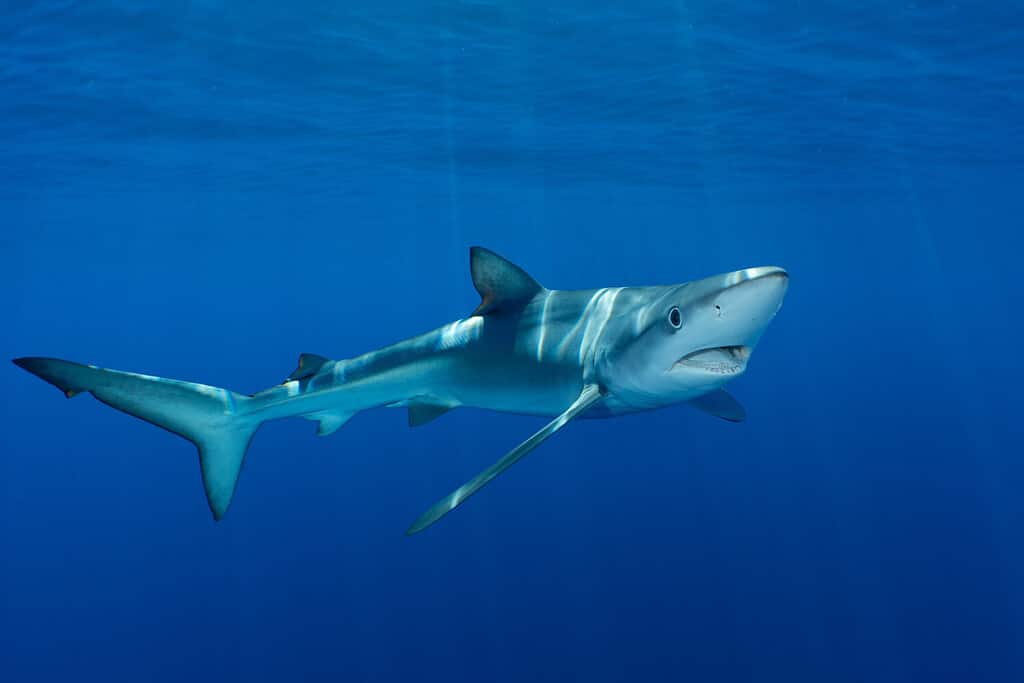
The blue shark occurs primarily in open ocean and inshore shallow waters where it hunts fish, cephalopods, and small seals.
©Samy Kassem/Shutterstock.com
6. Great White Shark (Carcharodon carcharias)
Likely the most famous shark on this list is the great white (Carcharodon carcharias). This shark is an incredible predator that inhabits coastal and open-ocean waters off British Columbia primarily in the spring and summer. The great white shark feeds on a variety of marine life including tuna, mackerel, seals, sea lions, porpoises, and sea turtles. They can grow to 20 feet in length and weigh up to 2,400 pounds. This gorgeous, ecologically critical shark can live 50-75 years.
Great white shark populations plummeted since the 1970s, but thanks to targeted conservation efforts, their numbers are starting to recover in some regions of the world, including the North Pacific Ocean. As water temperatures increase along the West Coast of North America, great white sharks are increasingly migrating further north into the waters of British Columbia.

During the warm months, you might spot a great white shark hunting marine mammals off the coast of British Columbia.
©Sergey Uryadnikov/Shutterstock.com
7. Broadnose Sevengill Shark (Notorynchus cepedianus)
As its common name suggests, the broadnose sevengill shark (Notorynchus cepedianus) is one of two known species that features seven-gill slit pairs. In contrast, about 99% of currently existing shark species have five-gill slits on either side of their body. The broadnose sevengill is the only member of its genus, Notorynchus, of the Hexanchidae family, which includes all 6 and 7-gilled sharks. This interesting, ancient species of shark can live to about 50 years old.
This unique shark can grow up to 10 feet long and primarily hunts along shallow, inshore waters. However, older individuals may be found to dive up to 1,600 feet. This species migrates to the coastal waters of British Columbia during the warm months.

The broadnose sevengill shark primarily hunts along shallow, inshore waters.
©Tomas Kotouc/Shutterstock.com
8. Bluntnose Sixgill Shark (Hexanchus griseus)
The bluntnose sixgill shark (Hexanchus griseus) is one of three existing species of sixgill sharks. These unique sharks are some of the most ancient in the world, with their extra gill slits and translucent eyelids linked to prehistoric shark species. Researchers estimate they can live up to 80 years.
Off the coast of British Columbia, where the continental slope gives way to deep waters, the bluntnose sixgill resides down to almost 7,000 feet. This mysterious shark can grow to 16-18 feet long and hunts nocturnally on a range of deep-sea prey including hagfish, sea lampreys, and chimeras.
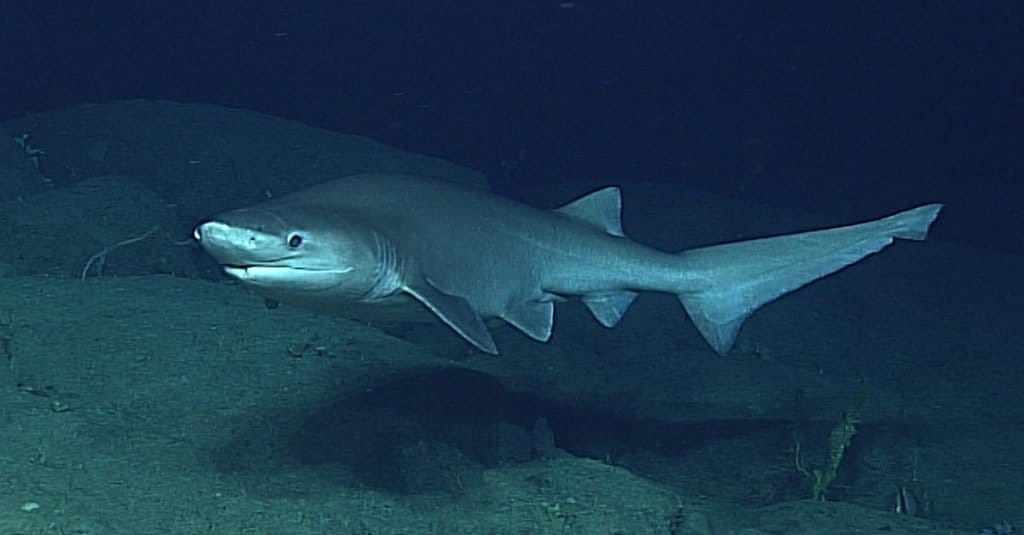
The bluntnose sixgill shark is a mysterious deep-water species that can occur to depths of about 7,000 feet.
©NOAA Ocean Explorer from USA / CC BY-SA 2.0 – License
9. Shortfin Mako Shark (Isurus oxyrinchus)
Sleek, slender, and one of the fastest sharks in the world, the shortfin mako (Isurus oxyrinchus) inhabits the open ocean where it hunts primarily quick-moving fish. If you take a boat out from the shores of British Columbia for a diving or spear-fishing trip, you might encounter one of these awesome animals. The shortfin mako can grow up to about 13 feet long and weigh over 1,000 pounds. They typically inhabit waters less than 300 feet deep, but they are capable of diving around 1,600 feet while hunting. Their prey consists primarily of squid and bony, open-ocean fish. This slow-growing shark can live at least 30 years.
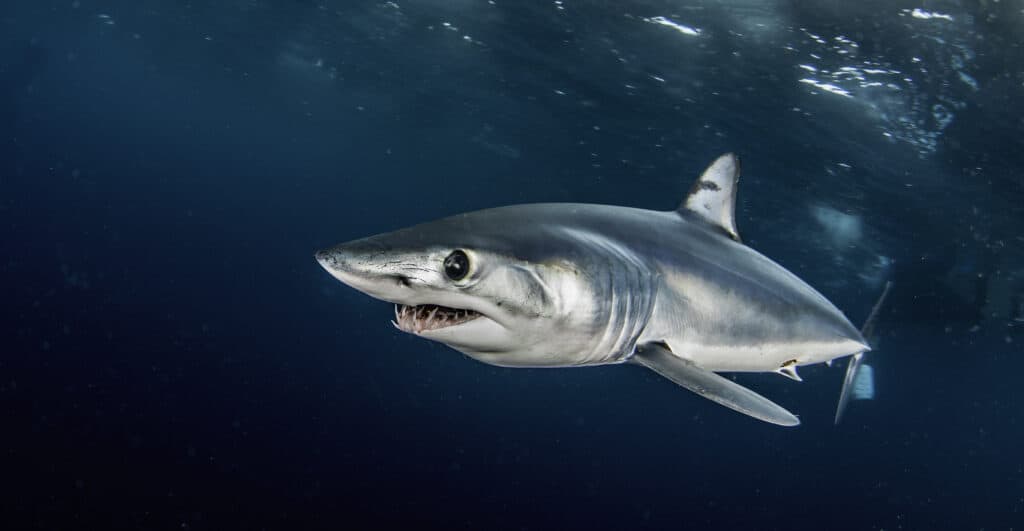
The shortfin mako inhabits the open ocean off the coast of British Columbia.
©wildestanimal/Shutterstock.com
10. Common Thresher Shark (Alopias vulpinus)
The common thresher shark (Alopias vulpinus) features a distinctive upper caudal fin (rearmost fin) that makes up more than half the total length of the shark. These interesting sharks use their long and extremely powerful tails like a whip to stun and immobilize prey. They tend to hunt fish that form schools, such as sardines. These impressive sharks can measure up to almost 20 feet in length and can live up to about 50 years. They tend to live in waters less than 300 feet and inhabit both coastal and open-ocean waters.
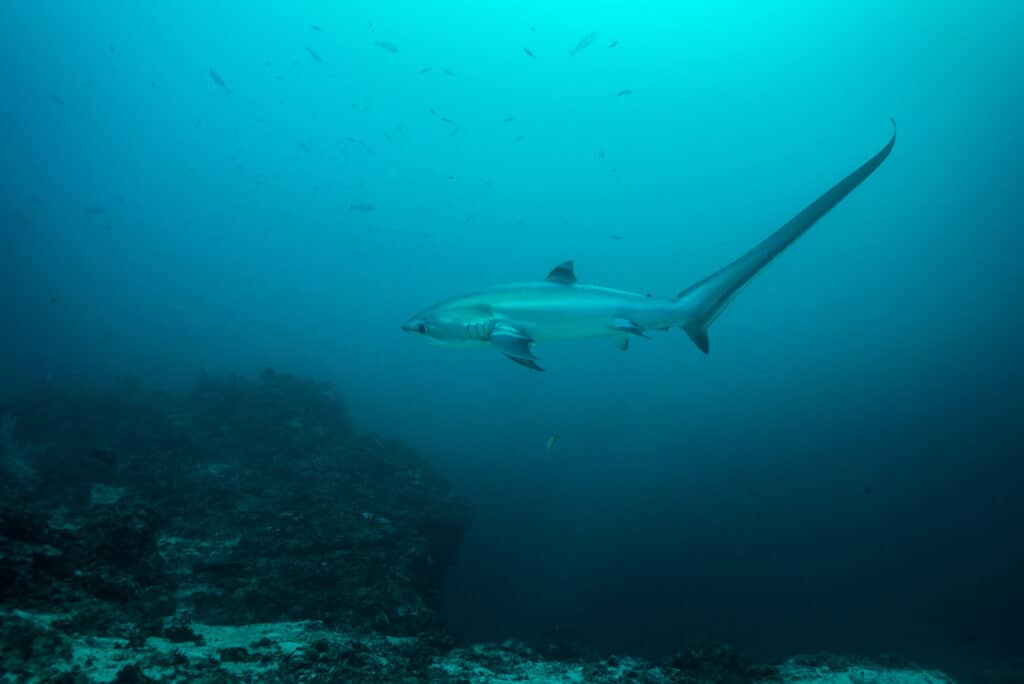
The common thresher shark hunts schools of fish, stunning and immobilizing them with its whip-like tail.
©bearacreative/Shutterstock.com
11. Bigeye Thresher Shark (Alopias superciliosus)
In addition to the common thresher shark, the bigeye thresher (Alopias superciliosus) also inhabits the waters off British Columbia. As its common name implies, this species of thresher shark has huge eyes adapted for low-light hunting conditions. Like the Pacific sleeper shark, the bigeye thresher stays in deep waters during the day and moves up the water column at night to hunt. In comparison to the likely long-lived common thresher shark, the big eye thresher typically only lives about 20 years.
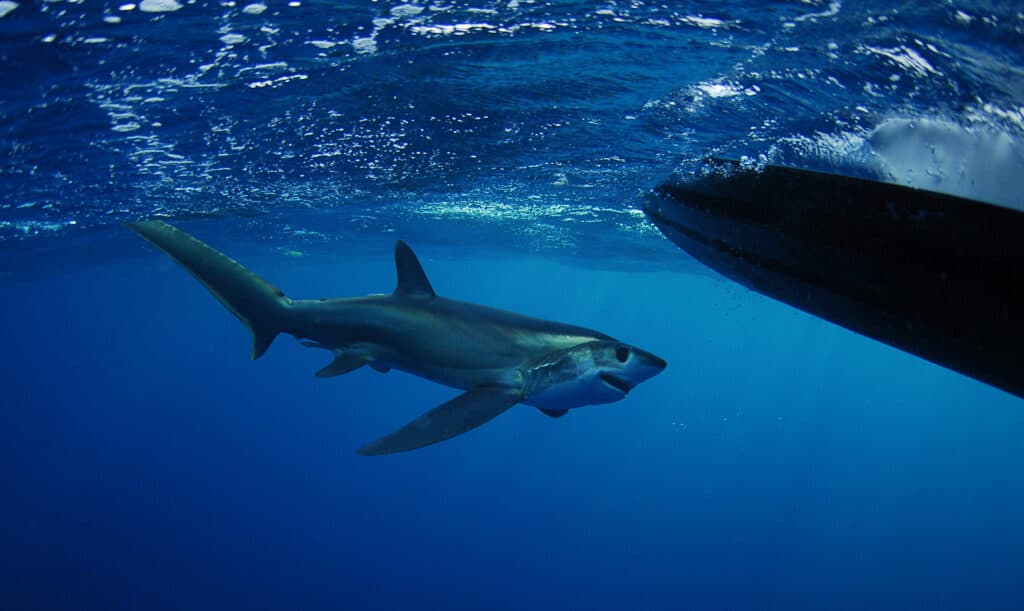
The bigeye thresher shark is smaller overall than the common thresher, but this species features larger eyes.
©FtLaud/Shutterstock.com
12. Basking Shark (Cetorhinus maximus)
The second-largest species of fish in the world, the basking shark (Cetorhinus maximus) is a filter feeder that can grow to 40-45 feet long. While the basking shark is primarily an open-ocean shark, it will also travel into coastal waters. While they certainly aren’t common in the waters of British Columbia, they are infrequently spotted in the summer months. As filter feeders, basking sharks use gill rakers to capture plankton and tiny crustaceans. This highly migratory, slow-moving species can live up to about 50 years.
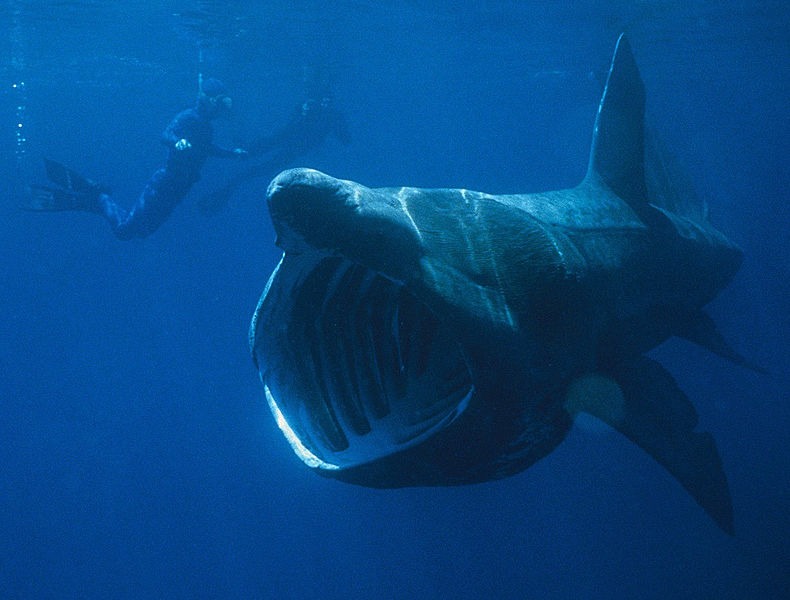
The second-largest fish in the world, the enormous basking shark filter feeds on some of the tiniest animals in the oceans.
©Chris Gotschalk / Public Domain, from Wikimedia Commons, the free media repository – License
13. Tope Shark (Galeorhinus galeus)
A highly migratory species, the tope shark (Galeorhinus galeus) occurs in temperature waters around the world, including off the coast of British Columbia. Tope sharks form schools and move efficiently together up to 35 miles per day. This slender shark can grow 6 feet long but only weighs up to about 100 pounds. They are abundant in shallow waters, continental zones, and deeper regions up to 1,800 feet. The life expectancy of this schooling shark is about 55 years. The tope shark has a wide-ranging diet including fish, crustaceans, cephalopods, and invertebrates.
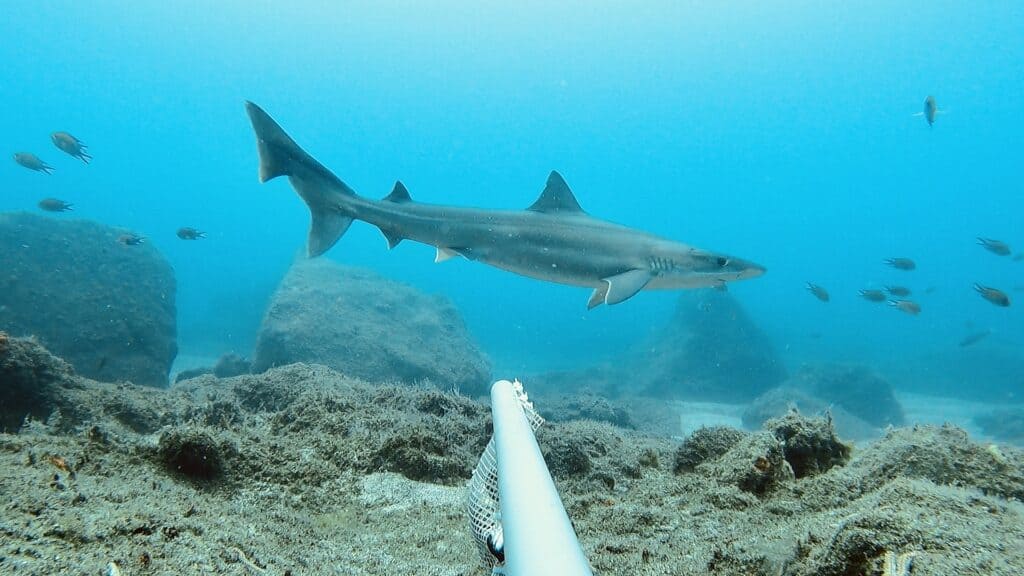
The tope shark often moves in schools. It can grow up to 6 feet long.
©AshlieJMcivor / cc by-sa 4.0 – License
| Names | Length in Feet | Weight in Pounds |
|---|---|---|
| Salmon Shark (Lamna ditropis) | 10 | 1000 |
| Pacific Spiny Dogfish (Squalus suckleyi) | 3.5 | 22 |
| Pacific Sleeper Shark (Somniosus pacificus) | 14 | 2000 |
| Brown Cat shark (Apristurus brunneus) | 2 | 3 |
| Blue Shark (Prionace glauca) | 10 | 528 |
| Great White Shark (Carcharodon carcharias) | 20 | 2400 |
| Broadnose Sevengill Shark (Notorynchus cepedianus) | 10 | 236 |
| Bluntnose Sixgill Shark (Hexanchus griseus) | 16-18 | 1300 |
| Shortfin Mako Shark (Isurus oxyrinchus) | 13 | 1000 |
| Common Thresher Shark (Alopias vulpinus) | 20 | 1100 |
| Bigeye Thresher Shark (Alopias superciliosus) | 10-13 | 350 |
| Basking Shark (Cetorhinus maximus) | 40-45 | 10,000 |
| Tope Shark (Galeorhinus galeus) | 6 | 100 |
The photo featured at the top of this post is © Alessandro De Maddalena/Shutterstock.com
Thank you for reading! Have some feedback for us? Contact the AZ Animals editorial team.






